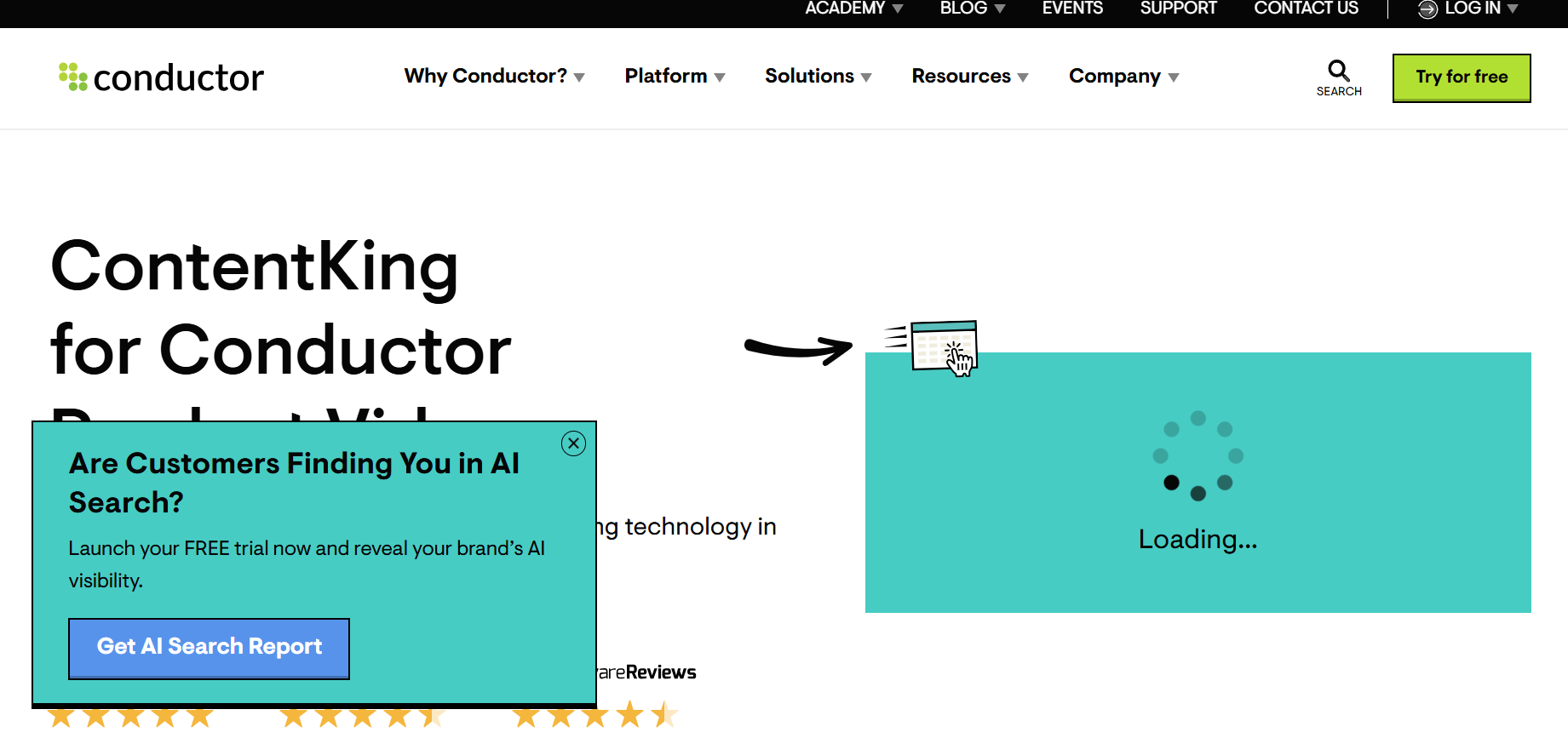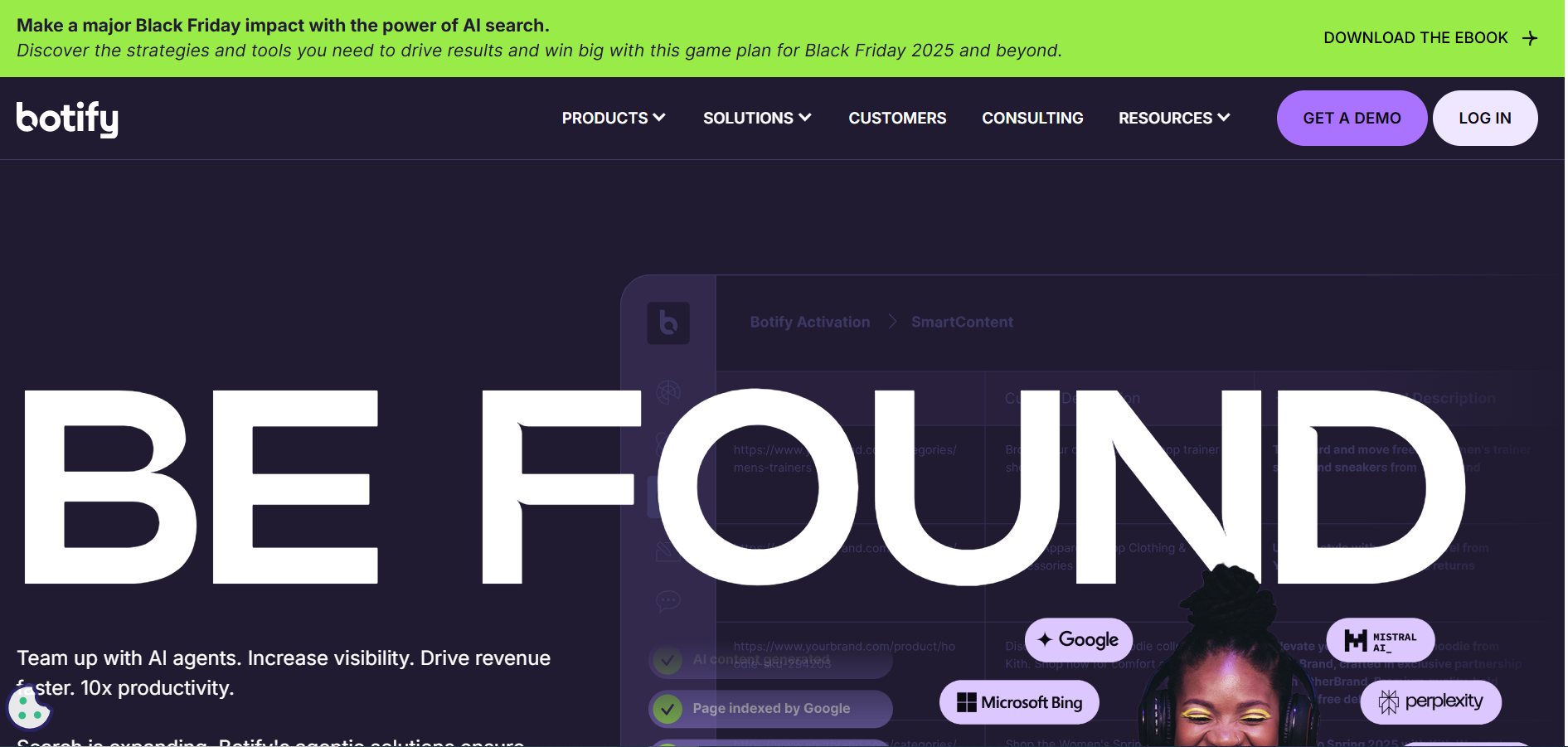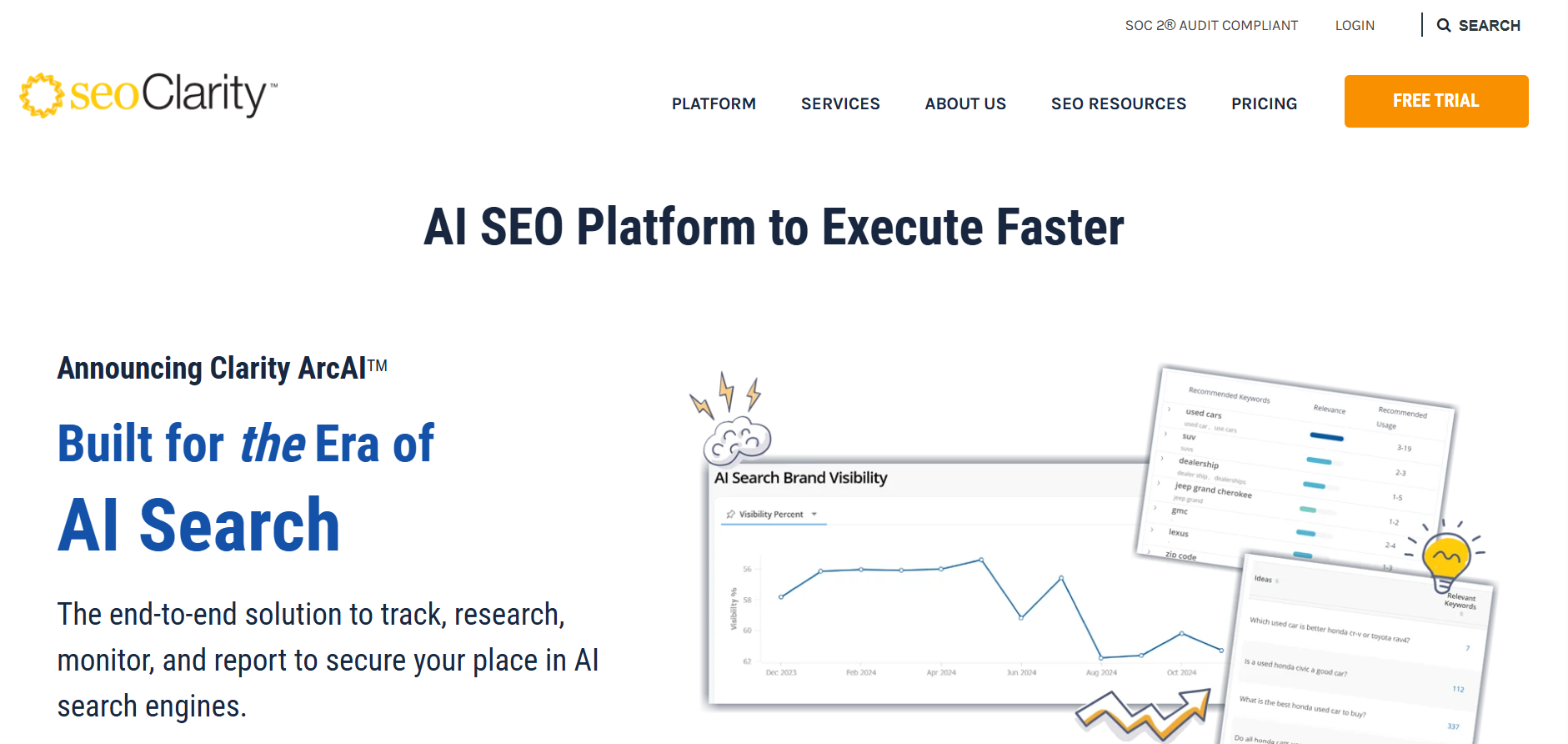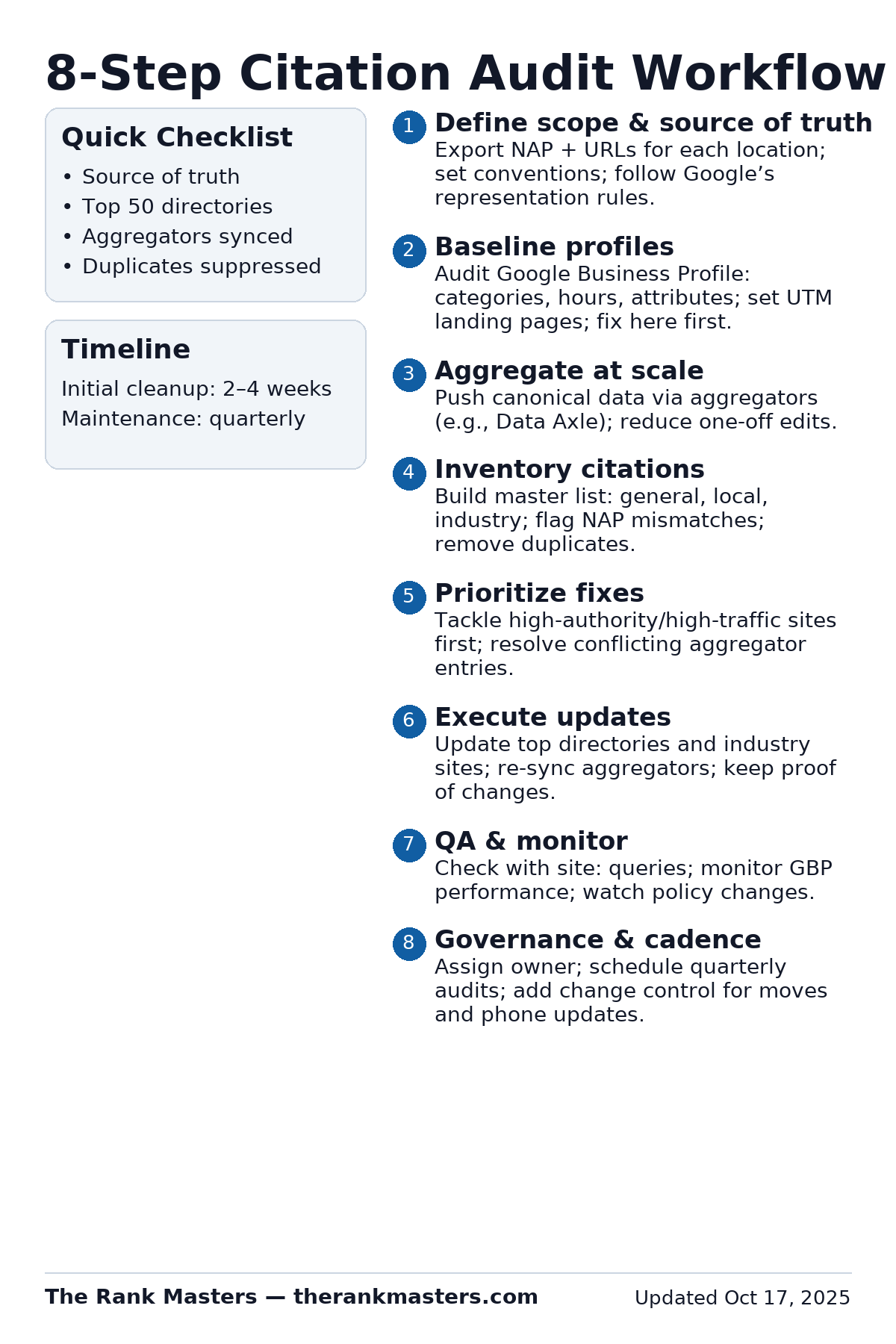💡 Quick Takeaway: The top enterprise SEO platforms in 2025 “BrightEdge, Conductor, Botify, seoClarity, Semrush Enterprise, and Ahrefs Enterprise” equip large organizations with automation, global reporting, and executive-ready analytics. Which tool is “best” depends on your stage of growth, how your teams operate, and the ROI you need to demonstrate.
Managing SEO at the enterprise level is less about tweaking metadata on a handful of pages and more about coordinating a system. We’re talking thousands of URLs spread across products, geographies, and languages, plus the added complexity of aligning growth, engineering, and content teams under one strategy.
As businesses scale, the stakes get higher: one misconfigured canonical tag or inefficient crawl path can waste crawl budget and suppress entire markets. That’s why forward-thinking teams lean on technical SEO audit tools for SaaS websites to catch technical breakdowns early, and pair them with AI content audit automation to accelerate content operations without sacrificing quality.
👉 The real danger? Choosing the wrong SEO stack. An underpowered platform slows down SQL generation and inflates CAC as paid channels are forced to pick up the slack. To sanity-check priorities before you scale, use a B2B SaaS content audit checklist to surface the highest-leverage fixes.
By 2025, the enterprise SEO playbook has shifted. Automation, cross-site reporting, and seamless integrations aren’t nice-to-haves “they’re the baseline”.
Modern leaders aren’t asking “How do we rank?” They’re asking: “How do we show SEO’s direct influence on pipeline, efficiency, and shareholder value?” That’s where automated SEO platforms for SaaS step in, unifying technical SEO, content velocity, backlink strategy, and board-ready reporting into one growth engine.
🤙 Ready to evaluate your stack? Book a 30-min strategy call with The Rank Masters and map your path forward.
Table of Contents
What is an Enterprise SEO Suite?
Enterprise SEO tools are platforms built for large or multi-site teams to crawl at scale, track rankings, analyze content, manage technical issues, and report to stakeholders. To choose one:
1) Define use-cases and users.
2) Audit data sources.
3) Shortlist 3 vendors.
4) Run a 14–28-day trial.
5) Score ROI vs cost and requirements.
The Tools Behind Enterprise SEO Success in 2025: Deep-Dive Comparisons
Choosing the right enterprise SEO platform isn’t about chasing brand names “it’s about aligning features, automation, and reporting depth with your growth bottlenecks”.
Below, we break down the leading tools of 2025, their real strengths, tradeoffs, and the SaaS scenarios where they deliver the most ROI.
| Tool | Best For | Stand-out Feature | Pros | Cons |
|---|---|---|---|---|
| BrightEdge | Enterprise content & governance | Page-level recs + dashboards | Mature workflows | Enterprise pricing |
| Conductor | Content operations | Writer/brief workflows | Strong support | Implementation time |
| Botify | Technical at scale | Log file analysis | Depth | Cost/complexity |
| seoClarity | Scalable platform | Content Fusion AI | Automation | Cost/fit varies |
| Semrush | All-in-one suite | Competitive intel | Easy start | Broad, not deepest |
| Ahrefs | Link & SERP analysis | Backlink index | Research power | Limited workflows |
| Lumar (Deepcrawl) | Technical & QA | CI/CD checks | Dev-friendly | Seats can add up |
| SEOmonitor | Forecasting & reporting | Budget/forecast tools | Exec reporting | Needs setup |
| Screaming Frog / Sitebulb | Audits | Flexible crawls | Value | Not a “suite” |
| GSC + Looker Studio | Free stack | Baseline data & dashboards | Free | Manual setup |
📋 Get Listed / Advertise
We refresh this guide monthly. Want your tool featured, benchmarked, or cited? Email: info@therankmasters.com
• Subject: “Rank Tracker Listing – TRM”.
1. BrightEdge: Turning SEO Into a Boardroom-Level Growth Lever

BrightEdge is the gold standard in enterprise SEO reporting. Rather than focusing on tactical fixes, it positions itself as the business intelligence layer for organic search. It helps CMOs and growth leaders connect SEO performance directly to ARR, SQL growth, and CAC efficiency, making it less about keyword rank checks and more about strategic ROI visibility.
Strengths:
- Executive-ready dashboards tied to ARR, CAC, and SQL growth.
- AI-driven content recommendations for editorial teams.
- Deep BI integrations (Salesforce, Tableau, Adobe Analytics).
- High data compliance/security standards.
- Premium customer success and onboarding.
Limitations:
- Pricing starts around six figures/year.
- Long onboarding cycle.
- More geared toward visibility than execution.
▶️ Best fit: Post-IPO SaaS brands or global companies where exec reporting outweighs tactical execution needs.
Risk if misused: Treating BrightEdge like a keyword tracker or site audit tool, you’ll massively overpay if you’re not leveraging the executive dashboards, BI integrations, and ARR reporting.
2. Conductor: Driving Alignment Between SEO, Content, and Demand-Gen Teams

Conductor brands itself as the collaboration-first SEO platform. It’s designed not just for SEOs, but to align SEO, content marketing, and demand-gen teams around shared workflows, insights, and performance dashboards. Think of it as the bridge between content strategy and organic performance.
Strengths:
- Excellent cross-team workflows.
- Content performance reporting for non-SEO marketers.
- Smooth CMS integrations (Adobe, Sitecore, WordPress).
- Strong enablement and customer support.
Limitations:
- Pricing isn’t transparent.
- Limited depth in technical SEO automation.
- More suited for marketing teams than dev-heavy orgs.
▶️ Best fit: Series B–C SaaS companies scaling PLG or content-led motions where alignment between content + SEO teams is the bottleneck.
Risk if misused: Over-relying on Conductor for growth while ignoring underlying technical SEO debt. You’ll scale content without fixing structural bottlenecks.
3. Botify: Solving Crawl Efficiency and Technical SEO Bottlenecks at Scale

Botify is the technical SEO engine for enterprise sites. Its core strength lies in log file analysis, crawl optimization, and large-scale site audits, making it a go-to for companies managing millions of URLs, complex architectures, or multi-country rollouts.
Strengths:
- Best-in-class log file analysis.
- Crawl optimization to prioritize high-value pages.
- Scales to millions of URLs.
- Automation for technical audits and fixes.
- CDN integrations for crawl performance.
Limitations:
- Setup-heavy, requires SEO engineers or technical leads.
- Expensive for smaller SaaS teams.
- Not intuitive for content teams.
▶️ Best fit: SaaS companies scaling internationally where crawl budget and technical SEO bottlenecks impact growth.
Risk if misused: Buying Botify without dedicated technical SEO + dev resources. It will sit idle if your team can’t act on the insights.
4. seoClarity: A Unified SEO Operating System for Global, Multi-Site Brands

seoClarity is the all-in-one SEO operating system. It covers both technical SEO and content optimization while layering in AI-driven insights and exec reporting. Its strength lies in scalability “handling multi-site, multi-region SEO programs while giving both execs and SEOs custom dashboards”.
Strengths:
- AI-driven recommendations across tech + content.
- Seamless multi-site scalability.
- Content Fusion AI for NLP-driven optimization.
- Customizable dashboards for both execs and SEO managers.
- Enterprise-grade security & governance.
Limitations:
- Complex UI → steep learning curve.
- Price point may be too high for growth-stage SaaS.
- Feature bloat if you only need specific modules.
▶️ Best fit: SaaS brands preparing for global expansion where both technical SEO and content scaling are equally critical.
Risk if misused: Paying for seoClarity’s breadth but only using a fraction of it, you’ll burn budget without driving ROI.
5. Semrush Enterprise: A Versatile SEO Toolkit for Growth-Stage SaaS Teams

Semrush is the Swiss Army knife of SEO. While not built originally as an enterprise-only tool, its Enterprise plan adds scalability, collaboration features, and integrations, making it a favorite for growth-stage SaaS scaling content velocity and competitor research.
Strengths:
- World-class keyword research with global SERP coverage.
- Easy-to-use content optimization tools.
- Competitive intelligence (keyword gaps, SERP tracking, competitor moves).
- Affordable relative to enterprise-only tools.
- Broad ecosystem of integrations (GA4, HubSpot, Looker).
Limitations:
- Technical SEO automation isn’t deep.
- Dashboards not C-suite polished.
- May require add-on tools for global scale.
▶️ Best fit: Growth-stage SaaS companies running content-led or PLG motions where speed, agility, and competitor insights matter most.
Risk if misused: Treating Semrush as a complete enterprise suite. Without supplemental technical SEO tools, it won’t scale to multi-site/global demands.
6. Ahrefs Enterprise: The Backlink and Competitive Intelligence Engine

Ahrefs is the link intelligence and competitor research leader. Its unparalleled backlink index and SERP visibility tools make it invaluable for companies where domain authority and competitive visibility are growth bottlenecks.
Strengths:
- Largest backlink index in the industry.
- Strong competitive keyword gap analysis.
- Easy for non-SEOs to use.
- Great for digital PR + link building campaigns.
Limitations:
- Weak in executive reporting.
- Lacks workflow/project management tools.
- Not a full SEO suite, best paired with other platforms.
▶️ Best fit: SaaS companies that need to close authority gaps quickly to challenge incumbents.
Risk if misused: Using Ahrefs as your only SEO tool. It should supplement a stack, not replace it.
✅ Micro-checklist for SaaS Operators:
- Technical SEO bottleneck → Botify or seoClarity.
- Content velocity bottleneck → Semrush or Conductor.
- Authority gap bottleneck → Ahrefs.
- Exec reporting bottleneck → BrightEdge.
📋 Get Listed / Advertise
We refresh this guide monthly. Want your tool featured, benchmarked, or cited? Email: info@therankmasters.com
• Subject: “Rank Tracker Listing – TRM”.
TL;DR Decision Table
| If you need… | Start with | Why | Watch-outs |
|---|---|---|---|
| Enterprise content intelligence + workflows | Conductor / BrightEdge | Strong content briefs & governance | Enterprise pricing, setup time. |
| Deep technical crawling at scale | Botify / Lumar (Deepcrawl) | Logs + JS rendering + automation | Seats/cost add up. |
| Broad suite + market/PR tracking | Semrush | All-rounder; fast onboarding | Can feel “jack-of-all-trades.” |
| Link intelligence & SERP research | Ahrefs | Best-in-class backlink index | Limited enterprise workflow. |
| Manager-friendly reporting | SEOmonitor / Looker Studio | Forecasting & budgeting | Needs good data plumbing. |
Defining Enterprise SEO: Core Capabilities That Separate Tools Built for Scale
When SaaS brands hit scale “thousands of indexed pages, multiple product lines, international rollouts, the SEO challenges multiply fast”.
At that point, “enterprise” isn’t just a higher license fee. It’s about whether the tool can actually orchestrate SEO as a growth channel across people, platforms, and regions.
Here’s what separates true enterprise-grade SEO software from point solutions:
1. Scalability That Matches Global Growth
You’re not tracking 50 keywords anymore “you’re tracking 50,000 across regions, languages, and product categories”. Teams at this stage often pair platform capabilities with programmatic SEO services to scale landing-page creation without hand-coding. A proper enterprise tool should be able to:
- Handle 10K+ URLs per crawl without choking.
- Run multi-region rollouts with localized keyword tracking.
- Centralize reporting across 5+ business units or markets.
2. Advanced Reporting That Ties to Revenue
Your CMO doesn’t care about keyword density—they care about pipeline influence and ARR lift. Enterprise SEO platforms should:
- Build C-suite dashboards showing organic’s contribution to SQLs and revenue (see SEO analytics dashboards for SaaS).
- Model ROI forecasts that justify budget allocation.
- Push data into BI tools (Tableau, PowerBI, Looker) for cross-channel visibility.
3. Workflow Management for Large Teams
Enterprise SEO is no longer one manager with a spreadsheet. It’s SEO managers, content teams, and agencies working in parallel. Tools must:
- Enable project management natively (or integrate with Asana, Jira, Monday).
- Assign tasks from audits directly to content or dev teams.
- Provide collaboration layers that track who owns what, when, a repeatable SEO content operations framework keeps everyone aligned.
4. Automation That Handles the Heavy Lifting
At enterprise scale, manual audits and checks are impossible. You need automation that doesn’t just flag issues but prioritizes them. Look for:
- Automated site audits that identify crawl errors, indexing issues, or broken links at scale.
- Log file analysis to understand how Googlebot interacts with your site.
- Rank tracking across geographies and SERP features with the best SEO rank tracking tools.
- Content optimization recommendations powered by NLP/AI.
5. Integrations to Prove SEO’s Business Impact
The CFO isn’t logging into your SEO tool. Enterprise platforms must integrate with the wider stack:
- CMS integrations (HubSpot, WordPress, Webflow, custom CMS).
- CRM + MAP integrations (Salesforce, HubSpot, Marketo) to tie SEO to pipeline.
- BI connectors so performance data flows into the same dashboards used for paid and product analytics.
✅ Micro-checklist: If a tool can’t handle 5+ sites, executive dashboards, and automated audits, it’s not enterprise-ready.
Choosing the Right Enterprise SEO Platform: Key Questions for SaaS Leaders
Selecting the right enterprise SEO platform isn’t just about comparing feature checklists; it’s about aligning the tool with your growth model, revenue goals, and team workflows.
For mid-market and growth-stage SaaS companies, the wrong decision often leads to overpaying for shelfware or under-investing in capabilities that directly influence SQLs, ACV expansion, and ARR growth.
Here’s a practical framework: 👇
1. Company Size & Needs
Ask yourself: Do you run 5 sites or 50? Are you scaling into new regions or consolidating global properties?
- If you’re an early growth SaaS scaling content velocity, you may need a tool optimized for keyword research, content workflows, and competitor insights (e.g., Semrush Enterprise).
- If you’re a Series C brand with global sites, choose tools that excel in multi-region reporting and technical SEO automation (e.g., Botify, seoClarity). For a buying overview that maps features to growth stages, review an ROI-first SEO tool stack for SaaS.
2. Reporting Requirements
Your exec team doesn’t need a keyword dump “they need visibility into pipeline contribution and ARR impact”.
- Tactical SEO reporting → For SEO managers optimizing content calendars.
- Executive dashboards → For CMOs/boards who want SEO’s share of SQLs, influenced revenue, and CAC efficiency.
👉 If the tool can’t generate ARR-linked dashboards or push data into BI tools (e.g., Tableau, Looker), it won’t win budget renewals, shortlist SaaS SEO reporting tools that already support these outputs.
3. Workflow Match
Ask: Does my team need deep collaboration or just reporting?
- SaaS orgs running PLG + content-led motions benefit from tools that integrate with Jira, Asana, or Monday, so SEO tickets don’t die in the backlog. Teams running lean need lightweight automation + simple task assignment instead of full PM platforms baked into SEO software. Use systems that reinforce collaborative SEO content planning so ownership and timelines are crystal clear.
4. Budget vs. ROI
Enterprise tools range from $30K to $150K+ per year. Align spend with your growth levers:
- If your ACV is $50K+ and organic drives SQLs, a premium platform is justified.
- If your CAC pressure is high, start with a mid-tier enterprise tool and reinvest savings into link building or content ops.
Always model: Will this tool unlock enough incremental pipeline to cover its cost within 2–3 quarters? For guardrails on planning, see content ROI for Series A startups.
5. Trial or Pilot First
Never buy off the demo deck. Enterprise SEO is highly context-driven: what works for a Fortune 500 won’t map 1:1 to a Series B SaaS with PLG.
- Run a pilot on one region or product line.
- Measure impact on crawl efficiency, rankings, and influenced SQLs.
- Scale org-wide once you see ROI signals.
✅ Micro-checklist for SaaS leaders:
- Pilot with 1 region/site → track SQLs + ARR impact → scale across all properties.
- Always model tool ROI vs. ACV uplift.
- Ensure BI + CRM integrations are non-negotiable.
Citation Audit Workflows for Enterprise Teams (mini how-to)

- Define scope & source of truth: Export brand-approved Name, Address, Phone (NAP) and URLs for every location; follow Google’s representation guidelines to avoid inconsistencies.
- Baseline your profiles: Verify Google Business Profile details first (categories, hours, site links); fix here before syndicating.
- Aggregate at scale: Push canonical data via data aggregators (e.g., Data Axle); this feeds hundreds of endpoints and reduces one-off edits.
- Inventory citations: Build a master sheet of existing listings using curated lists (general + location-specific) and flag NAP mismatches and duplicates.
- Prioritize fixes: Tackle high-authority/high-traffic directories and conflicting aggregator entries first; enforce a brand NAP style guide.
- Execute updates: Correct NAP/URL on top directories and industry sites, then re-sync aggregators; document proof (screenshots/confirmation emails).
- Quality assurance: Spot-check in Google (site: queries), monitor GBP performance, and watch for fake-review crackdowns that may affect visibility.
- Governance & cadence: Assign an owner, quarterly audits, and change-control (e.g., openings/moves/phone changes). For multi-location brands, schedule bulk updates before seasonal campaigns.
Frequently Asked Questions
The biggest mistake is treating the tool as a silver bullet. Buying Botify won’t fix your crawl issues unless you have engineers ready to act on the insights. Purchasing BrightEdge is wasted money if the CMO isn’t using the dashboards in QBRs. The tool must align with your bottleneck (content velocity, technical debt, or exec reporting) and you must commit resources to leverage it fully.
No. Tools are amplifiers, not replacements. They provide the data, automation, and reporting infrastructure, but you still need humans “SEO managers, content strategists, engineers” to execute. Agencies (like The Rank Masters) often help companies operationalize the tools and ensure adoption doesn’t stall.
Yes, most enterprise-grade tools offer CRM and MAP integrations (Salesforce, HubSpot, Marketo). This is critical for SaaS teams because it lets you tie organic leads and opportunities directly to pipeline. Without this integration, SEO can remain siloed as a “traffic channel” instead of a revenue driver.
An enterprise SEO suite (e.g., BrightEdge, Conductor, seoClarity) unifies modules (technical crawling, content workflows/briefs, rank tracking, dashboards, permissions, and SSO) so data and reporting live in one place for large teams. Point tools (e.g., Ahrefs, Screaming Frog, Sitebulb) specialize in a slice of SEO (research, links, crawling) and are cheaper/faster to adopt but require stitching data and processes together. Suites reduce swivel-chair work and centralize governance; points win on flexibility and cost.
Most teams can get access in days, but a full rollout typically takes ~2–8 weeks depending on SSO/security, user provisioning, data migrations, log ingestion, initial crawls, and dashboard/report builds; complex multi-domain sites take longer. Vendors like seoClarity highlight rapid account setup, while technical platforms such as Botify/Lumar underscore log and crawl integrations that add time but pay off in visibility analytics; use GSC’s Crawl Stats to validate early improvements.
BrightEdge leans into at-scale audits and dashboards (ContentIQ + StoryBuilder/Anomaly Detection), Conductor emphasizes content workflows and briefs for marketers, and seoClarity focuses on automation + AI writing/optimization (Content Fusion) with a heavy client success/onboarding layer. All three cover research, tracking, and reporting; choose based on team workflow (content-led vs. technical-led) and governance needs.
For all-in-one suites & collaboration, consider Semrush Enterprise or Ahrefs Enterprise; for deep technical scale, look at Botify or Lumar (Deepcrawl); for forecasting/reporting & budgeting, SEOmonitor is strong. Use suites when you need shared workspaces, permissions, and multi-brand reporting; pair with a technical platform if you manage JS-heavy, frequently changing sites.
It’s valuable if you need scaled content optimization and brief creation inside the platform so writers get AI-assisted outlines, entity coverage, and optimization guidance tied to your data; results depend on editorial standards and human QA. Evaluate it on content throughput, quality lift, and time saved, and pilot against a control group before wider rollout.
(1) Confirm Search Essentials compliance and crawling/indexability. (2) Run an enterprise crawl and fix critical technical blockers. (3) Analyze server logs to align crawl budget with high-value URLs. (4) Implement structured data and monitor coverage. (5) Build topic/keyword → brief workflows. (6) Deploy forecasting & reporting tied to business KPIs. (7) Document governance (roles, SLAs, change control) and schedule quarterly audits.
The biggest mistake is buying a suite without governance and data plumbing, which creates shelfware and fragmented execution; the fix is to appoint an accountable platform owner, define use-cases & success metrics, set up workflows/permissions, and align engineering with SEO via dashboards and phased rollouts before expanding seats.
Yes! AI features (AI Overviews/AI Mode) change visibility surfaces, but Google reiterates that success still hinges on useful, people-first content and solid technical foundations; enterprise tools are how you measure crawl/indexation, content quality, and emerging AI-search exposure, including tracking AI/answer engine bots in logs. Keep your stack and processes (just add AI-search monitoring).





